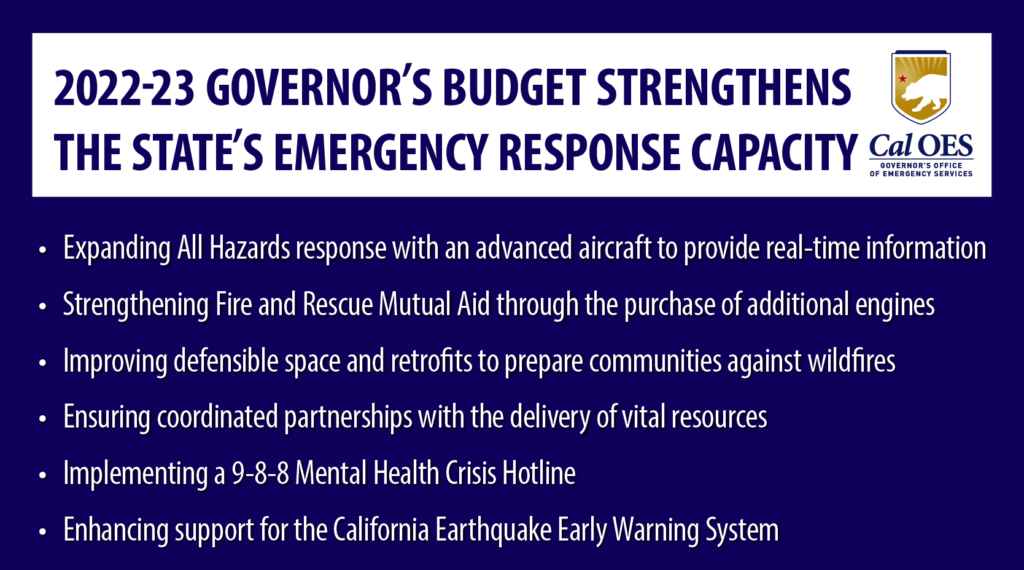In 2021, Californians endured some of the most challenging emergencies in state history, including the COVID-19 pandemic, catastrophic wildfires, oil spills and earthquakes.
With climate change continuing to intensify and lengthen the fire season in California, 10 of the 20 largest wildfires in state history have occurred since 2017, with six of those occurring in 2020 alone and 17 occurring since 2000.

The California Governor’s Office of Emergency Services (Cal OES) serves as the state’s leadership hub during all major emergencies and disasters. This includes responding, directing, and coordinating state and federal resources and mutual aid assets across all regions to support the diverse communities across the state.
Cal OES also supports local jurisdictions and communities through planning and preparedness activities, training, and facilitating the immediate response to an emergency through the longer-term recovery phase. During this process, Cal OES serves as the state’s overall coordinator and agent to secure federal government resources through the Federal Emergency Management Agency.
Governor Gavin Newsom today unveiled his proposed 2022-23 budget – the California Blueprint – which included $2 billion ($541.1 million General Fund) and 1,507 positions for Cal OES.
The budget includes funding for Cal OES to address the more frequent, complicated, and often simultaneous emergencies and disasters involving numerous counties and regions across the state.
The collateral and cascading impacts of California’s disaster events are reflected in the increasingly widespread damages, injuries, loss of lives, and economic disruptions that the state has experienced in recent years.
The proposed budget specifically includes:
Emergency Response Capacity and Capabilities
- Community Hardening – $44 million for Cal OES, CAL FIRE, and the UC Fire Advisors program ($13 million for Cal OES for home hardening) to improve defensible space and retrofits to harden homes and communities against wildfire ignitions.
- Modernizing All Hazard Response and Mutual Aid System Through Technology – $30 million and 31 positions ($24.4 million General Fund and 11 positions for Cal OES) to establish the Fire Integrated Real-time Intelligence System (FIRIS) program to increase the real-time information and situational awareness available to the state and California’s mutual aid system responders and managers on all hazards events, including wildfires.
- Enhancing the Fire and Rescue Mutual Aid Fire Fleet – $11.2 million General Fund in 2022 23, $10.9 million ongoing, and 11 positions to enhance the California State Fire and Rescue Mutual Aid System’s fire fleet.
- Providing Resources for Mission Tasking – $10 million ongoing General Fund to provide funding to state entities for costs incurred as a result of mission tasking for incidents not covered under a Governor’s proclaimed state of emergency.
- Addressing Heightened Risks Through Enhanced Partnerships – $5.8 million General Fund and 20 positions to enhance regional response capacity and key partnerships with local governments and other local stakeholders.
- Expanding Disaster Logistics Capabilities – $4.9 million General Fund and 21 positions to improve Cal OES’ core operations and effectiveness, foster quality improvement projects, and enhance emergency response capabilities.
Emergency Preparedness Infrastructure
- California Earthquake Early Warning System – $17.1 million ongoing General Fund to support education and outreach, operations, and research and development of the California Earthquake Early Warning Program.
- Cal OES Emergency Operations Centers and Security Improvements – $11.6 million General Fund to complete design and construction for a renovated State Operations Center (SOC) at the Cal OES facility in Sacramento and enhanced site security renovations.
Public Safety Communications
- Implementing a 988 Suicide Hotline—$7.5 million General Fund ($6 million ongoing) and 10 positions to implement a new federally mandated 988 call system to increase the ease and accessibility to provide help for those considering suicide or self-harm.
- Funding for call handling equipment so existing crisis hotline centers have the needed resources to process additional 988 calls and coordinate and transfer calls with no loss of information between the 988 and 911 systems.

